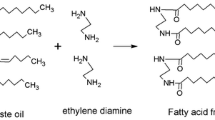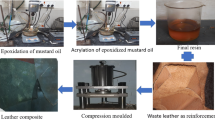Abstract
Petroleum-based composite materials have limitations in terms of environmental issues, and hence, research works have been going on to replace them with green composite materials. To the best of our knowledge, the synthesis of green oil as resin component and jute as reinforcement material in composites has never been explored. In the present study, epoxidized rice bran oil (ERBO) and acrylated epoxidized rice bran oil (AERBO) were used as toughening agent after blending with a diluter or copolymer, viz. polystyrene (PS) and anhydrides, i.e., maleic anhydride (MA) and phthalic anhydride (PA) as additional cross-linking agents to fabricate jute nonwoven-based composites. It was found that with the increase in copolymer content, there was an improvement in mechanical properties. But in the case of biodegradability test, the presence of additional cross-linkers showed less amount of weight loss due to the formation of compact structure. AERBO curing was optimized by varying the curing time and was characterized by FTIR, gel content and viscoelastic properties. Maximum tensile strength of 35.98 MPa was obtained with 50 wt% nonwoven jute. The composites showed improved thermal stability with anhydrides. Chemical resistance showed less deterioration with anhydrides. DMA analysis also showed an increase in storage and loss modulus with anhydrides and reduction in tanδ peak with its broadening. SEM micrographs showed good adhesion and cross-linking when anhydrides were used. These green composites have good potential to replace a large number of petroleum-based alternatives due to their inherent biodegradability and strength and can be used in automotive, constructions, water tanks and so on.







Similar content being viewed by others
References
Peek N (2010) Rapid prototyping of green composites, M.S. Thesis, Massachusetts Institute of Technology, School of Architecture and Planning
Nakamura R, Goda K, Noda J, Ohgi J (2009) High temperature tensile properties and deep drawing of fully green composites. Express Polym Lett 3:19–24
Luo S, Netravali AN (1999) Mechanical and thermal properties of environmental-friendly “green” composites made from pineapple leaf fiber and poly(hydroxybutyrate-co-valerate) resin. Polym Compos 20:367–378
Bajpai PK, Singh I, Madaan J (2014) Development and characterization of PLA-based green composites: a review. J Thermoplast Compos Mater 27:52–81
Arnold C, Alstone S (2018) Environmental impact of composite, Wlesh Composite Center, Swansea University, www.welshcomposites.co.uk. Accessed 4 Aug 2018
Bisanda ETN, Ansell MP (1992) Properties of sisal-CNSL composites. J Mater Sci 27:1690–1700
dos Santos PA, Giriolli JC, Amarasekera J, Moraes G (2009) Natural fiber plastic composite for automotive application. Ann Automot Compos Conf Exhib 1:492–500
Zini E, Scandola M (2011) Green composite—an overview. Polym Compos 32:1905–1915
Bismarck A, Baltazar-Y-Jimenez A, Sarikakis K (2006) Green composite as panacea? Socio-economic aspects of green materials. Environ Dev Sustain 8:445–463
Philip BM, Abraham E, Deepa B, Pothan LA, Thomas S (2014) In: Thakur VK (ed) Green composite from natural resources. CRC Press, Boca Raton
Kumar R, Yakubu MK, Anandjiwala RD (2010) Biodegradation of flax fiber reinforced poly lactic acid. Express Polym Lett 4:423–430
Drzal LT, Mohanty AK, Misra M (1999) Bio-composite materials as alternatives to petroleum-based composites for automotive applications. In: Proceedings of the automotive composites conference, Troy, MI, USA, 19–20 September 2001
Zhang H, Yang Y, Shen M, Shang S, Song J, Jiang J, Song Z (2018) Soybean oil-based thermoset reinforced with rosin-based monomer. Iran Polym J 27:405–411
Hernández-López S, Vigueras-Santiago E, Mercado-Posadas J, Sanchez-Mendieta V (2007) Electrical properties of acrylated epoxidized soybean oil polymers based composites. AZojomo. https://doi.org/10.2240/azojomo0236
Mohanty AK, Misra M, Hinrichsen G (2000) Biofibres, biodegradable polymers and biocomposites: an overview. Macromol Mater Eng 276–277:1–24
Khot NS, Lascala JJ, Can E, Morye SS, Williams GI, Palmese GR, Kusefoglu SH, Wool RP (2001) Development and application of triglyceride based polymers and composites. J Appl Polym Sci 82:703–723
Grishchuk S, Karger-Kocsis J (2011) Hybrid thermoset from vinyl ester resins and acrylated epoxidized soybean oil (AESO). Express Polym Lett 5:2–11
Habib F, Bajpai M (2011) Synthesis and characterization of acrylated epoxidised soybean oil for UV cured coatings. Chem Chem Technol 5:317–326
Stanzione JF, Sadler JM, La Scala JJ, Wool RP (2012) Lignin model compound as bio-based reactive diluents for lignin molding resin. Chemsuschem 5:1291–1297
Narine SS, Kong X (2005) Vegetable oils in production of polymers and plastics. In: Shahidi F (ed) Bailey’s industrial oil and fat products. Wiley, New York. https://doi.org/10.1002/047167849x.bio047
El-Shekeil YA, Sapuan SM, Abdan K, Zainudin ES (2012) Influence of fiber content on the mechanical and thermal properties of Kenaf fiber reinforced thermoplastic polyurethane composite. Mater Design 40:299–303
Wu G, Yang F, Tan Z, Ge H, Zhang H (2012) Synthesis of montmorillonite-modified acrylic impact modifiers and toughening of poly(vinyl chloride). Iran Polym J 21:793–798
Teli MD, Jadhav AC (2016) Extraction and characterization of novel lignocellulosic fibre. J Bionanosci 10:418–423
Zhao K, Song X-X, Liang C-S, Wang J, Xu S-A (2015) Morphology and properties of nanostructured epoxy blends toughened with epoxidized carboxyl-terminated liquid rubber. Iran Polym J 24:425–435
Teli M, Jadhav A (2017) Determination of chemical composition and study on physical properties of Sansevieria roxburghiana lignocellulosic fibre. Eur J Adv Eng Technol 4:183–188
Elkhouly HI, Abdel-Magied RK, Aly MF (2019) Date palm seed as suitable filler material in glass–epoxy composites. Iran Polym J 28:65–73
Acknowledgements
The authors would like to acknowledge the facilities made available by the DST, UGC BSR, Government of India through FIST and World Bank funded TEQIP-II in completing this research project.
Author information
Authors and Affiliations
Corresponding author
Rights and permissions
About this article
Cite this article
Kale, R.D., Jadhav, N.C. & Pal, S. Fabrication of green composites based on rice bran oil and anhydride cross-linkers. Iran Polym J 28, 471–482 (2019). https://doi.org/10.1007/s13726-019-00715-5
Received:
Accepted:
Published:
Issue Date:
DOI: https://doi.org/10.1007/s13726-019-00715-5




